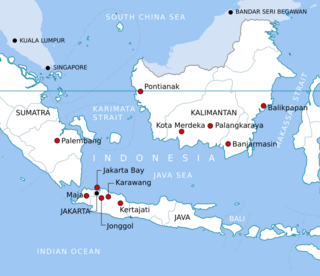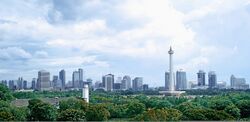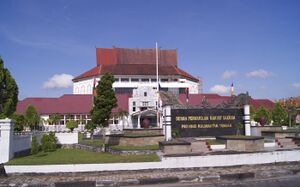Place:Indonesian future capital proposal
A proposal to move the Indonesian capital city from Jakarta to other locations has been discussed since the Sukarno presidency, and even earlier during the Dutch colonial era. In fact, in the early 20th century there was an effort by the Dutch East Indies government to relocate the capital from Batavia (colonial Jakarta) to Bandung.[1] In the 2010s, the idea to relocate the national capital or administrative center has been revisited, mainly because of Jakarta's environmental degradation and overpopulation problems.[2][3] In 2017, Palangkaraya was mentioned as a potential alternative.[4]
The business sector however, has expressed some mixed reactions, with some business voiced against the move. While some business expressed their willingness to support government's decision, Indonesia's Chambers of Commerce and Industry (Kadin), an influential business lobby group, is worried by the idea, arguing that businesses — most with its headquarters in Jakarta — need to consult and lobby the government on a regular basis. Thus the move would be inconvenient, and possibly costly for businesses.[5]
History
Early history
In Indonesian history, there has been examples of the transfer of capital practices. The capital of the 7th to 13th century Srivijaya empire, for example is believed has been moved several times with locations shifting between Palembang, Central Java, and Jambi. The Medang Mataram kingdom for example, is also known to move its court several times, such as the capital in Mataram area in Prambanan Plain in the 9th century, and later circa 10th century moved to East Java, somewhere in Brantas River valley.[6]:87:128 The idea to separate the commercial trading hub with royal capital, has been demonstrated during the 13th century Majapahit empire. The major trading ports were located in coastal cities of Hujung Galuh (modern Sidoarjo and Surabaya) and the port of Tuban, while the royal capital, the ceremonial center of politics and administration, was located inland in Trowulan.[7]
The 17th century Javanese Mataram Sultanate is also known to have moved its capital several times; from Kotagede to Kartasura, and later to Surakarta and Yogyakarta.
Colonial era
The Dutch colonial settlement of Batavia was established in 1621.[8] Initially, it was a European-styled walled city crisscrossed by Dutch-style canals located in a low-lying coastal swamp area. The poor sanitation and poor water drainage system made the city unhealthy, infested with malaria, cholera, and dysentry. In 1808, Daendels decided to quit the by-then dilapidated and unhealthy Old Town. A new town center was subsequently built further to the south, near the estate of Weltevreden. Batavia thereby became a city with two centers: Kota as the hub of business, where the offices and warehouses of shipping and trading companies were located; while Weltevreden became the new home for the government, military, and shops. These two centers were connected by the Molenvliet Canal and a road (now Gajah Mada Road) that ran alongside the waterway.[9]
In the early 20th century there was an effort by the Dutch East Indies government to relocate the capital from Batavia to Bandung. The idea was to separate the busy trading port or the commercial center (Batavia) from the new administrative and political center (Bandung). By the 1920s the plan to transfer the capital to Bandung was underway. As the city began the master plan of a well-planned new city, numbers of government buildings were constructed, such as Gedung Sate which was planned as the colonial administrative center of the Dutch East Indies. The plan however, failed due to the Great Depression and the outbreak of the Second World War.[1]
Republic era
During the Indonesian struggle for independence (1945-1949), the capital of the republic was moved several times — prompted by political and military emergency — as the seat of the republic in exile during the war. The capital moved from Jakarta to Yogyakarta (1946-1948) and then to Bukittinggi (1948-1949) as the seat of the Emergency Government of the Republic of Indonesia.[10] By 1949, the national capital of the republic was returned to Jakarta.
During Sukarno's presidency, Jakarta was established and developed as the capital of the new republic. In 1957, Sukarno laid the foundation and street grid layout of Palangkaraya as a new planned capital city of Central Kalimantan province. Sukarno however, foresaw the new city as the possible new national capital in the future. The vast available area and its geographic location in the center of the archipelago has become the main advantage of the city. Nevertheless, Sukarno seemed to favour Jakarta instead. In the late 1950s to the first half of the 1960s, he filled Jakarta with monuments and statues. Numbers of monumental projects were conceived, planned, and initiated during his administration, including Monumen Nasional, Istiqlal mosque, DPR/MPR Building, and Gelora Bung Karno stadium. Sukarno also filled Jakarta with nationalistic monuments and statues, including Selamat Datang Monument, Pemuda Monument at Senayan, Dirgantara Monument at Pancoran, and the Irian Jaya Liberation Monument at Lapangan Banteng. Although many of the projects were completed later, during the era of his successor (Suharto administration), Sukarno is credited for shaping Jakarta's monuments and landmarks. He desired Jakarta to be the beacon of a powerful new nation.[11]
In 1966, Jakarta was granted its official status as DKI (Daerah Khusus Ibukota) Djakarta, or the Special Capital Region. It promoted the rate of development of government office buildings and foreign embassies. Rapid development created the need for a master plan in order to regulate Jakarta's growth. Since 1966, Jakarta has steadily grown into a modern metropolis.[12]
During the Suharto's highly centralized New Order regime, Jakarta was further established as the political and economic core of the nation. Prompted with rapid development and urbanisation, Jakarta attracted large numbers of new settlers from all over the archipelago, with the majority coming from rural Javanese towns. High-rise buildings sprung up, especially in Jakarta's commercial and financial centers along Thamrin, Sudirman and Kuningan avenues. As the result, since the 1970s the population of Jakarta spiked tremendously, and spilled into areas surrounding the capital. The Jabodetabek or Greater Jakarta region has become the largest and the most densely populated urban agglomeration in Southeast Asia.
Massive overpopulation, coupled with a lack of urban infrastructures such as public transportation facilities; gridlock traffic; encroachment of urban areas replacing open green spaces; spread of slums within the city; over-extraction of ground water, and poor water drainage systems: all of these factors have led to ecological degradation of the city. As ground water was depleted, the city slowly sunk lower; parts of Northern Jakarta are below sea level and regularly suffer from flooding. Jakarta experienced massive floods in 2007, and again in 2013. These urban planning failures and environmental calamities have prompted the proposition to relieve Jakarta by reviving the idea of relocating its political and administrative center elsewhere.
In 2010, debate continued about the creation of a new capital city that would be separated from the urban, economic, and commercial center of the country. Former president Susilo Bambang Yudhoyono supported the idea to create a new political and administrative center of Indonesia, due to Jakarta's environmental and overpopulation problems.[2][3]
Bandung, the planned capital of the Dutch colonial era, was ruled out however, since the capital of West Java province itself is currently overpopulated and suffering ecological breakdown.[citation needed]
In April 2017, the Joko Widodo administration contemplated the idea of moving the capital from Jakarta. The government plans to conclude assessing potential alternative cities that would be suitable to become Indonesia's new capital by the end of 2017. According to an official from the National Development Planning Board (Bappenas), that the government determined to move the Indonesian capital out of Java, with Palangkaraya in Central Kalimantan was one of the options.[13]
The three alternatives
There are three major alternative approach about the new capital proposal:[14]
- Move the national capital altogether by creating a completely new planned city, similar to the way that Brazil moved its capital from Rio de Janeiro to Brasilia, a planned city, in 1960.
- Create a separate administrative center and keep Jakarta as the official capital, in the same fashion like Malaysia moved the federal administrative center to Putrajaya.
- Keep Jakarta as both capital and administrative center,[15] just like Tokyo for Japan.
Proposed new capitals
Since the idea was launched, numbers of provincial regional governments, governors and regents, have expressed their interest to be the host of the new capital. These are some options on the approach to create a new national capital:
New capital city
If the first option to create a completely new capital away from Jakarta would be chosen, then the island of Kalimantan is considered as a suitable location. The island is vast and away from Indonesian tectonic convergent boundary, which means it is relatively safe from earthquakes and volcanic eruptions. The suggested locations include:
- Palangkaraya, Central Kalimantan. Since it was established as the capital of Central Kalimantan province in 1957, the first president of Indonesia, Sukarno, outlined a plan to develop Palangkaraya as the future capital of Indonesia.[4] Palangkaraya is far larger in area than Jakarta and safe from the danger of earthquakes and volcanoes, common on the island of Java.[16]
- Banjarmasin, South Kalimantan. Compared to Palangkaraya, Banjarmasin is located closer to the center of the country, has better access to the Java Sea and has better infrastructure.[16]
- Kota Merdeka is a proposed planned city located north of Pangkalan Bun town, West Kotawaringin Regency, Central Kalimantan.[17] Compared to far inland Palangkaraya, Kota Merdeka is located nearer to coastal areas and has better access to Java Sea.
- Pontianak, West Kalimantan.[18] Located perfectly on the equator and strategically located by the Karimata Strait and the South China Sea, in the same region with other ASEAN capitals such as Singapore, Kuala Lumpur, and Bandar Seri Begawan. Despite its strategic location, the proposal is criticized for its proximity to the Malaysian border and disputed areas in the South China Sea.
- Between Balikpapan and Samarinda, East Kalimantan. According to East Kalimantan Governor, Awang Faroek Ishak, East Kalimantan possess all requirements to be Indonesia's new capital. The region is located right in the center of Indonesia, by Makassar Strait which has become Indonesia's second main maritime passage, connecting Indonesia to East Malaysia, the Philippines , China, Japan and Australia. Endowed with rich natural resources, especially timber, coal, oil and liquid natural gas, East Kalimantan has natural and financial resources to built infrastructure befitting a new Indonesian capital.[19][20][21]
- Palembang, South Sumatra. The city has historical significance, as the former capital of the Srivijaya maritime empire; which symbolize the return of the archipelago's former glory. It is also strategically located near the main maritime route of the Malacca Strait, near the other ASEAN capitals of Singapore and Kuala Lumpur.[22] Nevertheless, the plan is criticized for its geographic location in the west that is not the center of the archipelago, and its proximity to Malaysian and Singaporean borders.
New administrative center
If Jakarta is kept as the official capital, and the administrative centers would be moved to other locations not far from Jakarta, the suggested locations include:
- Jonggol, West Java. Dubbed as the most realistic option to move the capital city, Jonggol is located just 40 kilometres southeast from Jakarta, and has become a planned future capital of Indonesia since the era of the Soeharto presidency.[23] Jonggol is located in the province of West Java, a neighbouring province of Jakarta.
- Karawang, West Java, located about 60 kilometres east of Jakarta.[24]
- Kertajati, Majalengka Regency, West Java. Located about 200 kilometres east of Jakarta and 40 kilometres west of Cirebon. The proposed planned capital will be connected to the planned West Java new airport, Java railways and the Trans-Java toll road.[25]
- Maja, Lebak Regency, Banten. Located about 60 kilometres west of Jakarta. Most of Maja lands are already acquired by the government-owned Badan Penyehatan Perbankan Nasional (BPPN).[26]
- Jakarta Bay, North Jakarta. Rather than moving the capital away from Jakarta, land would be reclaimed north of Jakarta by reclaiming new islands in Jakarta Bay. In 2013, Joko Widodo, then Governor of Jakarta, proposed to move the administrative center of Indonesia to the planned future reclamated islands in Jakarta Bay. This plan is in line with the planned National Capital Integrated Coastal Development; the new administrative district will be located on a Garuda bird-shaped island planned to be built on Jakarta Bay.[27]
See also
References
- ↑ 1.0 1.1 Dino Fanara (2006). Angel of the East Indies: Biography of the Van Dooremolen Family. iUniverse. p. 55. ISBN 9780595860449. https://books.google.co.id/books?hl=id&id=Vh0j32NRF98C&dq=bandung+as+capital+of+east+indies&q=Bandung+capital+East+Indies#v=snippet&q=Bandung%20capital%20East%20Indies&f=false.
- ↑ 2.0 2.1 "Tiru Malaysia, SBY Dukung Pemindahan Ibukota". www.inilah.com. http://www.inilah.com/read/detail/798451/tiru-malaysia-sby-dukung-pemindahan-ibukota.
- ↑ 3.0 3.1 "SBY: Mari Lanjutkan Ide Membangun Ibukota Baru". news.okezone.com. http://news.okezone.com/read/2010/12/14/337/403406/sby-mari-lanjutkan-ide-membangun-ibukota-baru.
- ↑ 4.0 4.1 Jewel Topsfield; Karuni Rompies (13 April 2017). "Indonesia's capital Jakarta is so congested, government might move it to Borneo". Sydney Morning Herald. http://www.smh.com.au/world/indonesias-capital-jakarta-is-so-congested-government-might-move-it-to-borneo-20170413-gvkj7y.html.
- ↑ "Should Indonesia Move Its Capital?". The Jakarta Globe. http://jakartaglobe.id/business/indonesia-move-capital/.
- ↑ Cœdès, George (1968). The Indianized states of Southeast Asia. University of Hawaii Press. ISBN 9780824803681. https://books.google.com/books?id=iDyJBFTdiwoC.
- ↑ "Ying-yai Sheng-lan, The Overall Survey of the Ocean's Shores". Washington.edu. 1970. pp. 86–97 (Country of Chao-Wa). http://faculty.washington.edu/qing/huan_ying-yai_sheng-lan%5B1%5D.pdf.
- ↑ "Batavia" (in Dutch). De VOCsite. de VOCsite. 2002–2012. http://www.vocsite.nl/geschiedenis/handelsposten/batavia.html. Retrieved 27 November 2012.
- ↑ Gunawan Tjahjono, ed (1998). Architecture. Indonesian Heritage. 6. Singapore: Archipelago Press. p. 109. ISBN 981-3018-30-5.
- ↑ Kahin, Audrey (1999). Rebellion to Integration: West Sumatra and the Indonesian Polity. Amsterdam University Press. ISBN 90-5356-395-4.
- ↑ Silver, Christopher (2007). Planning the Megacity: Jakarta in the Twentieth Century - Planning, History and Environment Series. Routledge. p. 101. ISBN 9781135991227. https://books.google.co.id/books?id=UEaUAgAAQBAJ&pg=PA101&lpg=PA101&dq=Sukarno+build+Jakarta&source=bl&ots=0F4-oUZubF&sig=Il7M2TTKMMk5Hl9mo-PwbI_lCbc&hl=id&sa=X&ved=0ahUKEwimn4nilcrNAhUNR48KHcIkDj4Q6AEIPDAE#v=snippet&q=Sukarno%20buiild%20Jakarta&f=false.
- ↑ "History of Jakarta". Jakarta.go.id. http://www.jakarta.go.id/v2eng/news/2011/03/history-of-jakarta#.V3IZwBJPPIU.
- ↑ "Indonesia studies new sites for capital city". The Jakarta Post (Jakarta). 10 April 2017. http://www.thejakartapost.com/news/2017/04/10/indonesia-studies-new-sites-for-capital-city.html.
- ↑ VIVAnews - Pendapat Tujuh Pakar Soal Pemindahan Ibukota
- ↑ Jakarta Globe - Moving Indonesia's Capital ‘No Help to Jakarta’
- ↑ 16.0 16.1 Kota-kota yang Diusulkan Jadi Ibukota | koran terbaru – berita seputar indonesia
- ↑ "Pangkalan Bun Dan Sampit Cocok Jadi Ibu Kota Negara" (in Indonesian). Borneo News. 31 March 2015. http://www.borneonews.co.id/berita/14034-pangkalan-bun-dan-sampit-cocok-jadi-ibu-kota-negara.
- ↑ Elin Yunita Kristanti (28 July 2010). "Aria Bima Pilih Pontianak Gantikan Jakarta, Kata dia, Pontianak berada di tengah wilayah RI, paku buminya Indonesia" (in Indonesian). Viva. http://politik.news.viva.co.id/news/read/167539-aria-bima-pilih-pontianak-gantikan-jakarta.
- ↑ Gubernur: Kaltim siap menjadi ibukota negara
- ↑ Kaltim Siap Gantikan Jakarta Jadi Ibu Kota
- ↑ http://banjarmasin.tribunnews.com/2013/10/27/kaltim-siap-menjadi-ibu-kota-negara
- ↑ Palembang Ikut Diusulkan Jadi Pengganti Jakarta, Detik.com
- ↑ Tempointeraktif.Com - Pemindahan Ibu Kota ke Jonggol Lebih Realistis
- ↑ VIVAnews - Pemindahan Ibukota: Pakar ITB: Jonggol & Karawang Bukan Jawaban
- ↑ "Kertajati, Usulan Terkini Ibu Kota Baru" (in Indonesian). Republika. 20 January 2013. http://www.republika.co.id/berita/nasional/umum/13/01/20/mgx013-kertajati-usulan-terkini-ibu-kota-baru. Retrieved 11 November 2014.
- ↑ "Lebak Diusulkan Calon Ibu Kota RI" (in Indonesian). Warta Kota. 30 January 2013. http://wartakota.tribunnews.com/2013/01/30/lebak-diusulkan-calon-ibu-kota-ri.
- ↑ Hery H Winarno (20 April 2016). "Cerita Jokowi ingin pindahkan Ibu Kota di pulau reklamasi" (in Indonesian). Merdeka. http://www.merdeka.com/jakarta/cerita-jokowi-ingin-pindahkan-ibu-kota-di-pulau-reklamasi.html.





